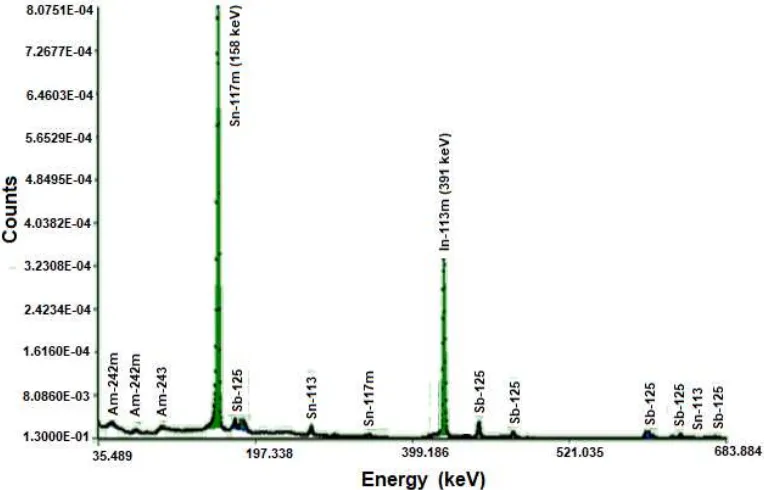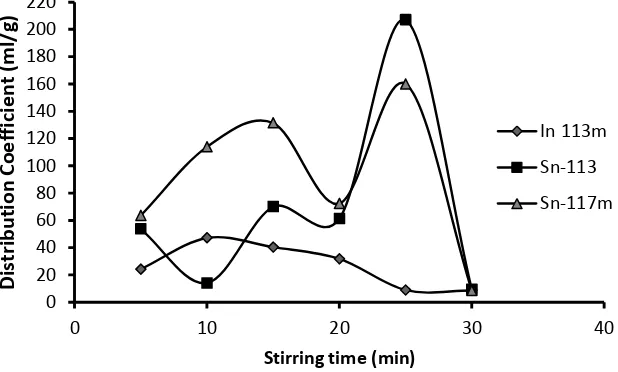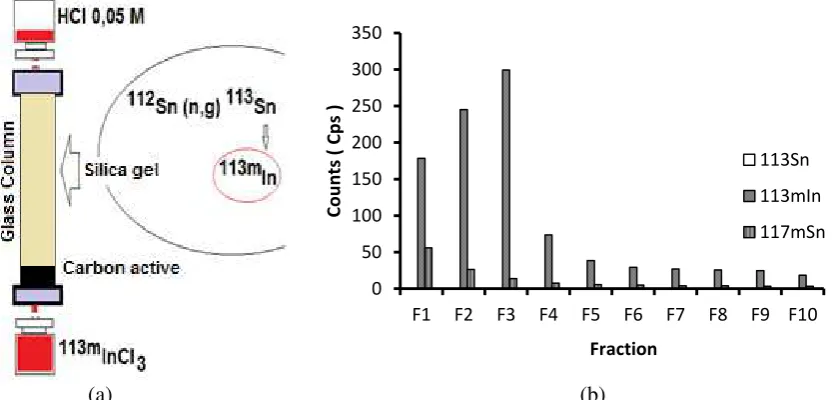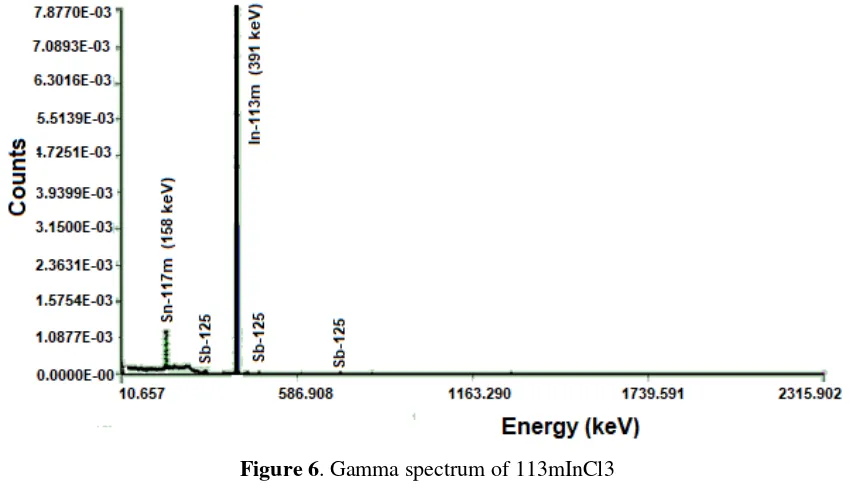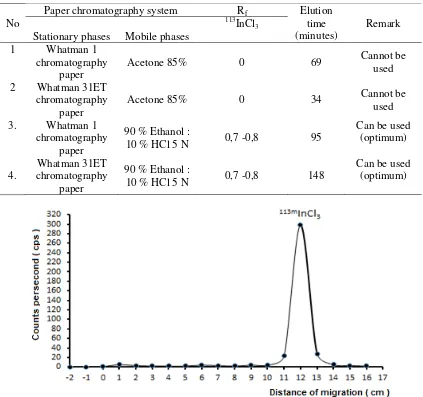Separation Of Radioisotope 113mIn Using Column Chromatography Based on Silica Gel Matrix
Duyeh Setiawan1*, M. Basit Febrian1, Yanuar Setiadi1
1
Centre of Applied Nuclear Science and Technology – National Nuclear Energy Agency, Bandung, West Java, Indonesia
*email: [email protected]
Received November 21, 2017; Accepted December 3, 2018; Available online December 8, 2018 ABSTRACT
Radioisotope indium-113m (113mIn) with half-life, T1/2 = 1.7 hours and gamma energy, E = 391 keV is suitable and meets the criteria as radiotracer in industry. 113mIn radioisotope was obtained from tin-113 decay (113Sn, T1 / 2 = 115 days) of 112Sn (n,) 113Sn neutron activation in nuclear reactor. The process of separation of radioisotope 113mIn using column chromatography method based on silica gel matrix using 0.05 M HCI solution. Radionuclide and radiochemical purity tests were performed using the gamma-spectrometry method and paper chromatography. The final product specification in the form of 113mInCl3 is clear solution, pH 2, obtained yield of 81.83%, radionuclide purity of 90.22%, radiochemical purity of 91.61 ± 0,29% and stable for 3 days at room temperature.
Keywords: 113 mIn radioisotopes, silica gel, chromatography, radiotracer, industry
INTRODUCTION
The rapid advance in radiotracer investigation has aroused widespread interest in the use of short-lived gamma-emitting radionuclides, especially for many industrial and nuclear medicine applications that require radioactivity for several minutes to several days. By using the short-lived radionuclide tracers, we could conduct measurement repetitions in short interval of time without having to worry about the remaining activities from the previous test. One of the disadvantages of using short half-life gamma emitter radionuclides as the industrial and nuclear medicine tracer is practical problems that only be used at near location to the nuclear reactor facility, because the short half-life limits the transport problem at the delivery distance. Therefore, timely availability in investigation location is the main obstacles that limit the use of this tracer in the industry and nuclear medicine.
To ensure a continuous supply of short-lived radionuclides, radioisotope generators (RG) are an effective strategy for solving practical problems. RG thus facilitates the activities in remote locations and also enables fast service delivery to handles urgent problems. Provision RG (in industry) would be cheaper than medical (nuclear medicine) radionuclide generators since there is no necessary to comply with strict regulatory requirements of radiopharmaceuticals.
Many couples of parent and daughter radionuclides have potential to be used in RG system, in this research, 113Sn was selected to be evaluated on the basis of half-lives, types of radiation and energy as well as ease of production. Parent radionuclide, 113Sn decay 98.2 percent to 113mIn as a daughter radionuclide which possesses 391.69 keV of gamma energy and a half-life at 1.7 hours, likely to be used as RG 113Sn/113mIn in the nuclear medicine and industry. While the half-life of the parent is 115 days, this generator offers about 1 year of application (International Atomic Energy Agency, 2013; Mostafa, A. El-Sadek, El-Said, & El-Amir, 2009; Tárkányi et al., 2011).
Considering that 113Sn radioisotope is neutron reaction products from 112Sn (n, ) which has natural isotope abundances in the amount of 0.97 % and a very small cross-section of 1 barn, it is necessary to use 112Sn enriched isotope (enrichment more than 95%). 113
anionic form InCl4- (Abdel-Halim, 2002; Narita et al., 2014).
The utilization of radioisotopes 113mIn that has a medium half-life (1.7 hours), low gamma energy (391 keV) and excess chemical properties of various concentrations of chloride, 113mIn become the main choice in the application of nuclear techniques for industrial/ hydrology field. One of the activities in hydrology is to reduce the speed of sedimentation (silt/sediment) in boat harbor by knowing where it came from and the direction of movement of these sediments (International Atomic Energy Agency, 2011). Besides that, 113m
In has the potential utilization in various industrial fields as a tracer for aqueous phase, organic or solid. To understand the behavior of each stage of tracing process is important to investigate the performance of the system, indium-113m is possible for labeling complex compounds that stable in these phases (Toncheva, Gavazov, Lekova, Stojnova, & Dimitrov, 2011). Radioisotope 113Sn was obtained by neutron activation or irradiation of the 112Sn in a nuclear reactor. Separation process of Indium-113m from RG 113Sn/113mIn by elution with HCl 0.2 N to obtain 113mIn3+ ions, (113mInCl3). How to mastery 113mInCl3 radioisotope production from nature tin metal target using column chromatographic separation methods based on silica gel matrix is the purpose of this research.
EXPERIMENTAL SECTION
Reagents and Instrumentation.
Materials used in this study are tin (Sn) metal from E. Merck, hydrochloric acid, silica gel 60 (from 0.063 to 0.200 mm) from E. Merck Catalog No. 107 734 (70-230 mesh ASTM), hydrogen peroxide (H2O2 30%), distilled water, ammonium molybdate (1%), phosphate buffer (Na2HPO4), activated carbon (0.3 to 0.5 mm), universal pH indicator paper, 90% ethanol, 85% acetone, Whatman 1chromatography paper (E. Merck), Whatman 31ET chromatography paper (E. Merck), and Whatman 3MM chromatography paper. While the equipments used are cutlery quartz, analytical balance METTLER toledo AL 204, micropipette (Eppendorf), centrifuge, heater (Thermolyne) brand Nouva II, spectrometer γ single channel (SCA) ORTEC models 402 A, spectrometer-γ multi-channel (MCA) with a detector HPGe Canberra DSA-1000, oven
Heraeus T5050, nuclear reactors GA Siwabessy BATAN, hot cells, glove boxes, container, inner and outer aluminum capsule (nuclear grade) , quartz glass, glass columns, syringes (Terumo syringe), glass vial, set of paper chromatography system including chamber, beakers, measuring cups, measuring pipette, pasteur pipette, tweezers, spatula, and gloves (Sensi gloves).
Irradiation and chemical process of 112Sn target.
1000 mg Sn metal target containing quartz glass was placed in the aluminum nuclear grade inner capsule, and then closed by welding. Furthermore, the inner capsule was conducted via bubble method in water media. After that, the inner capsule was inserted into the outer capsule for irradiation process in a reactor RSG-GA Siwabessy (BATAN, Serpong) at CIP (Center Irradiation Position) with neutron flux of 1 x 1014 n.cm-2.s-1 for ± 94.5 hours. Irradiation was completed with Sn Safety Analysis Reports (SARs) document.
Irradiated material target was removed from the aluminum container, then put into a 250-ml beaker and dissolved in 100 ml of HCl 6 N. Dissolving process has been done on a heater with temperature of 80 °C, and was stirred gently at the same time with a magnetic stirrer to completely dissolved, then added 2 drops of concentrated H2O2. Thereafter, the solution was evaporated slowly until 50 mL left. Sn2+ qualitative test was performed by pipeting 20 L of the solution diluted to 1 mL, and were added by 1 drop of ammonium molybdate. The change of blue color indicates cation Sn2+ (Allan et al., 2010). In this process
Determination of optimum condition for impregnation process of irradiated Sn metal into silica gel.
Solvent concentration variation
0.5; 1 N) by adding distilled water. The solution was homogenized by stirring for ± 25 minutes. Then, silica gel was separated from the solution using a centrifuge. Next, pipette as ± 20μL filtrate and measured the radioactivity using Multi-Channel Analyzer instrument. Finally, do the calculation of the distribution coefficient. The distribution coefficient of three key radioisotopes i.e. 113Sn, 113mIn, and 117
mSn was calculated as the ratio of the radioactivity concentration of each radioisotope on solid matrix compared to the radioactivity concentration of those radioisotopes on the solution.
Stirring time variation and 30 minutes. Then, silica gel was separated from the solution using a centrifuge. Next, pipette as ± 20μL filtrate and measured the radioactivity using Multi-Channel Analyzer instrument. Finally, do the calculation of the distribution coefficient.
Weight variation of silica gel
Weigh silica gel into 6 vial bottle with different mass (100;200;250;300;400;500 mg), then fill each vial with 1 ml solution of active Sn- metal in HCl 0,1 N (item 2.2.1). The solution was homogenized by stirring for 25 minutes (item 2.2.2). Then, silica gel was separated from the solution using a centrifuge. Next, pipette as ± 20μL filtrate and measured the radioactivity using Multi-Channel Analyzer instrument. Finally, do the calculation of the distribution coefficient.
Separation process of 113mIn by using silica gel chromatography column
Weigh ± 250 mg of silica gel into vial bottle then fill each vial with 1 mL solution of active Sn- metal in HCl 0,1 N (item 2.2.1). The solution was homogenized by stirring for 25 minutes (item 2.2.2). The solution was added to a glass column chromatography (ø 0.5 cm x 7.5 cm). Silica gel remains in the column, while the parent solution is removed and collected. 113mIn elution using 0.05 M HCl solution, the filtrate is collected 10 times of 1 mL per fraction/ vial. Then, 113mIn radioactivity was measured by the Multi Channel Analyzer (HPGe-MCA).
Radionuclide and radiochemical purity test of 113mIn.
Radionuclide purity was determined from gamma ray spectrum of 113mIn as the HPGe-MCA analysis result. 5 µL dosage of radionuclide 113mInCl3 was dropped on filter paper, dried, put in a plastic wrapper, and counted for 60 minutes. γ-ray spectrum characteristic of 113mInCl3 at 391 keV energy peaks. The radionuclide purity (KRN) of 113mIn was calculated using the equation below:
While the radiochemical purity was determined by paper chromatography using a mixture of 90% ethanol and 5 M HCl 10% (v / v) or acetone 85% as mobile phases and Whatman No.I chromatography paper as a stationary phase was observed at retention factor as 0.7 of In (III). 113mInCl3 solution was dropped at a distance of 2 cm from the bottom of Whatman 1, then the paper was put to the chamber that had been saturated by the eluent. Elution was carried out until the migration distance of the mobile phase reaches 14 cm. The paper was dried, cut every 1 cm and counted using γ-counter single channel analyzer (SCA).
RESULT AND DISCUSSION
Irradiation result of 112Sn target
10 µL solution of the target (section 2.1) dropped on the vial and radioactivity concentration was measured using a spectrometry-γ MCA-HPGe. Gamma spectrum was analyzed, measurements were performed 3 times of repetition. Identification 113Sn and 113m
In radioisotopes were determined using BATAN BANDUNG NAA software (Lestiani, Muhayatun, & Adventini, 2009) and resulted in a graph between counts and the energy as shown in Figure 1. The peak at 255 keV was 113
Sn counts and 391 keV for 113mIn radioisotope. Figure 1 showed the presence of other radionuclides than 113Sn and 113mIn which formed, were 117mSn and 125Sb radionuclides which derived from the core reaction of their isotopes by neutron at irradiation process. 117m
Sn came from the decay of irradiated result 116
contained in metal Sn target (Cradarelli, 2008; Duyeh, Nana, & Titin, 2013).
Radioactivity 113Sn as a form [113SnCl6] 2-obtained by measurement using the spectrometry-γ MCA-HPGe was 0.0467 mCi/mL, while theoretically at EOI (End Of Irradiation) should be 0.0504 mCi/mL, means obtained yield was 92.65%. Decay reactions that occur between parent radioisotopes (113Sn) and daughter radioisotope (113mIn) were secular equilibrium reaction where in 113Sn has a half life 115 days, relatively longer than 113mIn as 1.6 hours, allowed for separation by column chromatography using silica gel matrix (Saha, 2010).
Distribution Coefficient (KD) Determination
Solvent concentration variation
Distribution coefficient values resulted from the experiment (show as Figure 2) indicated that the radionuclide 113Sn and 113mIn can be separated using silica gel in a suitable solvent. The higher value of KD indicated the nuclide had stronger interaction and well absorbed into silica gel matrix. The optimum concentration of HCl to impregnate 113Sn as parent nuclide of 113mIn was achieved in 0.1N where KD of 113Sn was 156.27 ml/g. Although this process could not separate 113Sn from other Sn radionuclide 117mSn which had KD of 110.44 mL/g, impregnation process using this concentration can separated 113mIn from its
parent nuclide. On the optimum point (using HCl 0.1 N), 113mIn had low KD. The KD of 113m
In was around 20 mL/g which mean some 113m
In was trapped in silica gel matrix. Higher KD value of 113Sn and lower KD value of other nuclide indicated the better impregnation process. Beside solvent type and concentration, KD value is influenced by contact time and the amount of solid matrix. Figure 2 showed the optimum distribution coefficients was achieved in 0.1N HCl with KD of 113Sn was 156.27 mL/g and KD of 113mIn was 16.11 mL/g, therefore KD of 117mSn was 110.44 mL/g.
Stirring time variation
The results of the analysis of the distribution coefficient determination based on agitation time as shown in Figure 3. Figure 3
visualized the optimum distribution coefficient was obtained at stirring process or contact time for 25 minutes with the values of KD of 113mIn, 113
Sn and 117mSn were 8.86 mL/g, 206.95 mL/g and 159.98 mL/g respectively. The effect of agitation time on KD was not clear enough. This might be caused from inconsistency of stirring speed. Generally, KD of 113Sn is higher than 113mIn almost in all variation of time. However, the KD value resulted from 25 minutes of agitation showed the highest KD of 113
Sn with the low KD of 113mIn. This time parameter was used in preparation of the column chromatography.
Figure 2. Coefficients distribution at solvent concentration variation
Figure 3. Coefficients distribution at contact time variation
Weight of silica gel variation
The analysis result of the distribution coefficient based on the weight variation of silica gel as shown in Figure 4. Figure 4
visualized the optimum distribution coefficient was obtained at 250 mg silica with the values of KD of 113Sn was 240.12 mL/g, KD of 113mIn was 8.79 mL/g, and KD of 117mSn was 179.30 mL/g. Similar to time parameter determination result, the effect of the amount of solid matrix on KD of 113Sn did not show the good pattern. Since the using of 250 mg of silica gel showed the optimum KD, this amount of solid matrix with agitation process within 25 minutes in 0.1 N of HCl were used in preparation stationary phase for separation process of 113mIn from 113
Sn via column chromatography technique.
113m chromatography system. The column was
rinsed by 0.05 N HCl and the bottom of the column was sealed with a rubber stopper and aluminum cap (Figure 5a). To the 250 mg of silica gel was added 1 mL of 113Sn in 0.1 N HCl. 113Sn solutions containing silica gel were homogenized by stirring for 25 minutes while heated at a temperature of 60 °C. Furthermore, the solution was added to a glass column (ø 0.5 cm x 7.5 cm) that the bottom of the column already contained activated carbon (Figure 5a), the aim of activated carbon addition was to
that the silica gel-based column chromatogra-phy combined with carbon active are potential to be used for separation of 113mIn from irradiated natural tin.
Radionuclide and radiochemical purity test of 113mInCl3
Radionuclide purity (KRN) 113m
InCl3 radionuclide purity was tested using gamma ray (γ) spectroscopy, Multi-Channel Analyzer (MCA) equipment wiyh a gamma ray (γ) spectrum pattern as shown in
Figure 6. Figure 6 indicates the characteristics of the γ-ray spectrum of 113m
InCl3 at 391 keV peak, which means that this production process can generate both 113mIn products as 113mInCl3.
These results are relevant to the information described by Allan, et al. (2010), that the 113mIn has gamma emission with an energy of 391 keV and a half-life of 1.7 hours. Data collection from gamma ray spectrum analysis 113m
InCl3 is summarized in Table 1. Table 1
showed 113mInCl3 radionuclide purity was 90.22%, but there were other radionuclides, 125
Sb (0.47%) as the result of the core reaction of 124Sn (n, ) 125Sb, and 117mSn radionuclides (7.90%) as the core reaction product 116Sn (n, ) 117
Sn which has a natural isotopic abundance of 14% (Creech, Moynier, & Badullovich, 2017).
Figure 4. Coefficients distribution at weight of silica gel variation
(a) (b)
Figure 5. (a) silica gel column chromatography, (b) elution profile of 113mInCl3 solution 0
40 80 120 160 200 240 280
0 100 200 300 400 500 600
D
istr
ib
u
ti
on
Co
eff
icient
(m
l/g)
Weight of silica gel (mg)
In 113m
Sn-113
Sn-117m
0 50 100 150 200 250 300 350
F1 F2 F3 F4 F5 F6 F7 F8 F9 F10
Cou
n
ts
( Cp
s )
Fraction
113Sn
113mIn
Figure 6. Gamma spectrum of 113mInCl3
Table 1. Analysis result of 113mIn gamma spectrum
Energy
(keV) Counts (cps)
Activity (µCi/mL)
Intensity
(%) Radionuclide KRN (%)
158,56 129,327 0,0034 2,11 117mSn 7,90
391,68 960,603 0,0388 64,97 113mIn 90,22
175,90 2,270 0,0002 6,84 125Sb 0,47
427,87 2,553 0,0002 29,60 125Sb 0,47
462,83 0,786 0,0002 10,49 125Sb 0,47
635,71 0,100 0,0002 11,22 125Sb 0,47
TOTAL 0,043
Radiochemical Purity 113m
InCl3 radiochemical purity was determined by paper chromatography method by control the stationary phase compared to variable mobile phases. In the preparation of the solution of 113mInCl3, 113mIn was expected to be in the form of a single compound, namely 113m
InCl3. Paper chromatography systems were conducted in this study as summarized in
Table 2. Table 2 showed the chromatographic system that was used is Whatman 1 chromatography paper as the stationary phase and a solution mixture of 90% ethanol: 10% HCl 5 N as the mobile phase with an elution time of 95 minutes. Using of Whatman 31ET chromatograph system as the stationary phase and a solution mixture of 90% ethanol: 10% HCl 5 N as the mobile phase with the elution time of 148 minutes also can be used. Chromatogram sample with this system is shown in Figure 7. Figure 7 showed the paper chromatography system which was used to determine the radiochemical purity 113mIn are using Whatman 31ET paper as the stationary
phase and solution mixture of 90% ethanol: 10% HCl 5 N as the mobile phase. In this study resulted in a chromatogram with Rf 0.7 to 0.8 as 113mIn’s peak with a radiochemical purity of 91.61 ± 0.29%. These results are relevant with study that used a mixture of 90% ethanol: 10% HCl as eluent with Rf 0.7 at Whatman 1 chromatography paper (Allan et al., 2010).
Stability determination 113m
InCl3 solution stability in 3 days storage at room temperature showed that 113m
InCl3 remained clear and unchanged pH. While radiochemical stability was conducted by paper chromatography method by using mixtures of 90 % ethanol: 10 % HCl 5 N eluent. Radiochemical stability is showed in
physico-chemical factor of the solution and environmental factor. Thus, by storing InCl3 radioisotope solution in room temperature, it
was sufficient to maintain radiochemical purity between 80% - 100% (Uccelli et al., 2018).
Table 2. Paper chromatography system variation
No
Paper chromatography system Rf Elution time (minutes)
Remark Stationary phases Mobile phases
113 InCl3
1 Whatman 1 chromatography
paper
Acetone 85% 0 69 Cannot be
used
2 Whatman 31ET chromatography
paper
Acetone 85% 0 34 Cannot be
used
3. Whatman 1 chromatography
paper
90 % Ethanol :
10 % HCl 5 N 0,7 -0,8 95
Can be used (optimum)
4.
Whatman 31ET chromatography
paper
90 % Ethanol :
10 % HCl 5 N 0,7 -0,8 148
Can be used (optimum)
Figure 7. 113mInCl3 in chromatography system solution 90% ethanol: 10% HCl 5 N as eluent and Whatman 31ET chromatography paper
Figure 8. Radiochemical stability of 113mInCl3 in mixture 90 % etanol : 10 % HCl eluent 0.00
10.00 20.00 30.00 40.00 50.00 60.00 70.00 80.00 90.00 100.00
1 2 3
R
ad
io
ch
e
m
ic
al
p
u
ri
ty
(%
)
CONCLUSION
113m
InCl3 radioisotopes were obtained by irradiation of a metal tin target material (Sn-concentration of 0.0467 mCi/mL while theoretically was 0.0504 mCi/mL, obtained a yield of 92.65%. The optimum conditions of separation of radioisotopes 113Sn / 113mIn were obtained at a solvent concentration of HCl 0.1 N, stirred for 25 minutes and a silica gel’s weight of 250 mg. The obtained 113mInCl3 was a clear solution, pH 2, the activity was 0.0388 μCi/mL with a yield of 81.83%, radionuclide purity of 90.22%, and radiochemical purity of 91.61 ± 0.29%.
ACKNOWLEDGEMENTS
Authors thank to Ms. Fuji Octa Indah Suciati, undergraduate student in chemistry at General Achmad Yani University who helped complete this research. Acknowledgments to the Applied Nuclear Science and Technology Center - National Nuclear Energy Agency as research funder.
REFERENCES
Abdel-Halim, A. A. (2002). Study on 113
Sn-113m
In Generator of the Chromatographic Column Elution Mode. Cairo University. Allan, K. F., Ali, M. M. S., Hanafi, H. A., &
El-Azony, K. M. (2010). Separation of 113m
In from 113Sn based on activated carbon used as column matrix. Journal of Radioanalytical and Nuclear Chemistry, 284(2), 297–301. https://doi.org/10.1007/ s10967-010-0492-x
Cradarelli, F. (2008). Materials Handbook: A Concise Desktop Reference. Refractories. Springer. https://doi.org/10.1016/S0261-3069(00)00075-3
Creech, J. B., Moynier, F., & Badullovich, N. (2017). Tin stable isotope analysis of geological materials by double-spike MC-ICPMS. Chemical Geology, 457, 61–67.
https://doi.org/10.1016/J.CHEMGEO.201 7.03.013
Duyeh, S., Nana, S., & Titin, S. (2013). Physicochemical analysis of
radio-isotopes high specific activity 117mSn from tin-oxide target by Szilard-Chalmers' reaction (Analisis fisiko-kimia radioisotop 117mSn aktivitas jenis tinggi dari sasaran timah oksida menggunakan reaksi szilard-chalmers). In Prosiding Seminar Nasional TAN 2013 (pp. 16–22). International Atomic Energy Agency. (2011). Radiotracer Applications in Wastewater
Treatment Plants. Vienna:
INTERNATIONAL ATOMIC ENERGY AGENCY. Retrieved from http://www-pub.iaea.org/books/IAEABooks/8552/Ra diotracer-Applications-in-Wastewater-Treatment-Plants
International Atomic Energy Agency. (2013). Radiotracer Generators for Industrial Applications. Vienna: INTERNATIO-NAL ATOMIC ENERGY AGENCY. Retrieved from http://www-pub.iaea.org/ books/IAEABooks/8921/Radiotracer-Generators-for-Industrial-Applications Lestiani, D. D., Muhayatun, M., & Adventini,
N. (2009). Application of Neutron Activation Analysis in Characterization of Environmental SRM Samples. Indo. J. Chem., 2009, 9 (2), 231 - 235 231 APPLI,
Sn/113mIn Dual Radioisotope Generator Based on 6- Tungstocerate(IV) Column Matrix. Journal of Nuclear and Radiochemical Sciences, 10, 1_1-1_12. https://doi.org/10.14494/jnrs.10.1_1 Narita, H., Tanaka, M., Shiwaku, H., Okamoto,
Y., Suzuki, S., Ikeda-Ohno, A., & Yaita, T. (2014). Structural properties of the inner coordination sphere of indium chloride complexes in organic and aqueous solutions. Dalton Transactions,
43(4), 1630–1635.
Tárkányi, F., Hermanne, A., Király, B., Takács, S., Ditrói, F., Baba, M., & Ignatyuk, A. V. (2011). Investigation of activation cross sections of deuteron induced reactions on indium up to 40MeV for production of a 113
and Isotopes, 69(1), 26–36. https://doi.org/10.1016/j.apradiso.2010.0 8.007
Toncheva, G. K., Gavazov, K. B., Lekova, V. D., Stojnova, K. T., & Dimitrov, A. N. (2011). Ternary ion-association complexes between the indium(III) - 4-(2-pyridylazo)resorcinol anionic chelate and some tetrazolium cations. Central European Journal of Chemistry, 9(6),
1143. https://doi.org/10.2478/s11532-011-0101-z
Uccelli, L., Boschi, A., Martini, P., Cittanti, C., Bertelli, S., Bortolotti, D., … Bartolomei, M. (2018). Influence of Storage Temperature on Radiochemical Purity of 99m
Tc-Radiopharmaceuticals. Molecules,
23(3), 661.
